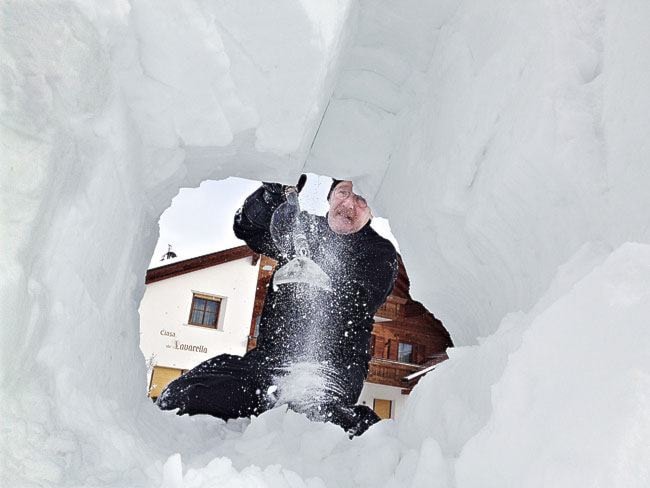Yukon’s snow-sculpting team is carving up a storm on their 2013 world tour.
They’re fresh off a first-place and a second-place finish at back-to-back competitions in Italy.
After 25 years, Donald Watt and the Yukon team are at the top of their game and are the team-to-beat anywhere they go in the world.
But the two events in Italy were anything but easy, said Watt.
“They’re tough competitions because they pick up the European contingent. And it’s also tough because they put us up in five-star hotels and they overfeed us! Oh my goodness, the snap on my snow pants keeps popping.”
The team, which also includes Michael Lane, Terry Gunderson, Adam Green and Evi Watt, had three days to turn a three-cubic-metre block of snow into a work of art. Then they were bused to another town to do it all over again.
San Candido and San Vigilio are ski towns nestled in valleys of the Italian Dolomite mountains, close to the Austrian border. San Candido features crooked, narrow streets with cattle barns tucked between high-end ski resort hotels. The border has shifted so many times over history that the town also goes by its Austrian name, Innichen.
There, the team carved the story of the brave hunter who travelled far out onto the ice floes to spear a giant walrus for his family. That carving took second place.
In San Vigilio the team told the story of sister sun and brother moon, a creation tale about the beginnings of the earth’s light.
Some of the competitors were art students being trained to carve Italian marble.
“They’re a tough group to beat,” said Watt.
Travelling around the world and learning from other artists is one of the perks of being a snow carver, said Watt. Language barriers can be an issue, but never hinder communication completely.
“There’s sort of the language of art, so a lot of pointing and nodding and stuff,” said Watt.
“Books come out and sketchpads come out and ideas get drawn and photos come out. Everyone now with their iPhones and that, have tons of photos to show you.”
Watt and this team start planning their season in the summer. They research northern Canadian myths and stories and imagine how they might be told in sculpted snow.
The design has to be appropriate for the dimensions of the snow block they will be given and also the amount of time they will have to complete the sculpture, both of which vary from place to place.
[image2]
Once they have sketched out their idea, they build a scale model called a maquette where one inch represents one foot. This helps them quickly measure and cut away the blocks of snow they don’t need for the sculpture.
By now, Watt’s an old pro, but that wasn’t always the case.
His first experiments in snow carving were in Grade 9 art class, where his teacher directed the students with three-dimensional aptitude to go outside and sculpt the snow piles around Prince George.
Things got more serious when Watt moved to the Yukon about 30 years ago.
The Yukon Sourdough Rendezvous was offering a cash prize for the best snow sculpture around town, and Watt needed the money to visit his wife and daughter in Winnipeg.
“I bought a ticket on spec that I would win the competition, and carved this piece, and I won!”
Now, hundreds of sculptures later, he doesn’t remember what he carved to earn the coveted prize.
A few years after that first win, Quebec’s snow sculpting event was looking for a team from every province and territory, so Watt cobbled together a group.
“We went down there totally unprepared to tackle the snow conditions and the fact that they actually gave us a block of snow - up until then I had been carving piles of snow.”
Things really took off about 15 years ago when Michael Lane joined in.
“He asked me why I don’t ever finish my sculptures,” said Watt. “I said, ‘Well, I’m an impressionist.’ He said, ‘Yeah but, the public can’t tell what you’re actually doing.’ So he started cleaning up my sculptures and we started winning more and more.”
Watt helped start Whitehorse’s own international snow carving competition about 10 years ago.
Gilles Lapres, who worked for the city at the time and has recently passed away, suggested the idea to Watt.
“I said, ‘I don’t have access to big trucks and a crew and front-end loaders,’” said Watt. “And he said, ‘Well I do, so let’s make this happen.’”
This year’s event will be held in Shipyards Park in conjunction with Rendezvous.
Artists will come from countries around the world, including Estonia, China and Guatemala, to compete.
The public is invited to come out on the evenings of Feb. 12 and 13, starting around 7 p.m., to help make the snow blocks that will eventually reveal the art hidden inside them.
Snow will be trucked in from the baseball diamonds along Robert Service Way and dumped into an open-top wooden box.
After each couple of scoopfuls of snow from the loader, people have to climb into the box and stomp down the snow until it is packed tight and has no air pockets.
This process is repeated until the three-cubic-metre box is full. When the casing is removed, it reveals a block of snow. It will take two nights to make blocks for the 10 or 11 teams that will compete in the event.
Carving will begin on the 20th, and judging is on the 23rd.
One Mexican carver, set to compete in the event, is having a hard time getting travel visas for his teammates, said Watt.
He may require a diligent assistant who speaks Spanish and can provide some muscle power for the event.
If anyone is interested, they should get in contact with Watt.
Contact Jacqueline Ronson at
jronson@yukon-news.com
